A pear perfectly poached in red wine is one of the most elegant desserts I can think of. Top it off with a little Crème Anglaise and you have elevated the lowly pear into something almost regal. I’m not really sure why, but it seems like poached fruit is a dessert almost no one makes anymore. I haven’t seen poached fruit on a restaurant menu in years. Is it because we generally want something richer and sweeter for dessert? I don’t really know, but I think it is the perfect time for a poached fruit revival!
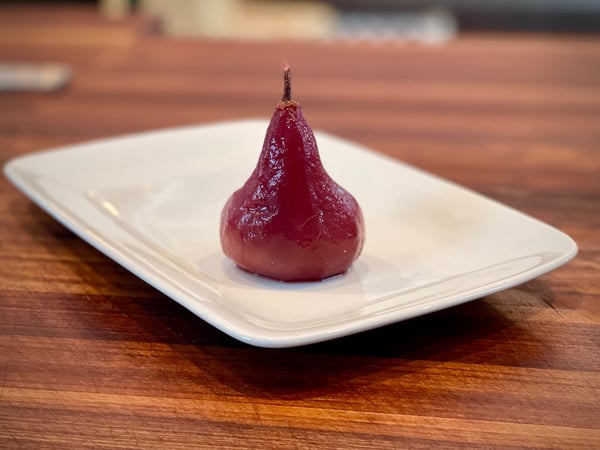 Poached fruit is a relatively quick dessert to make, gluten free, lower in sugar and fat than most desserts, visually stunning and packed full of flavor. Poached fruit is a perfect way to end a heavy and or rich winter meal and an equally complimentary pairing for a light spring menu. You are sure to turn a few heads and bring some smiles to your guests with this stunning French classic.
Poached fruit is a relatively quick dessert to make, gluten free, lower in sugar and fat than most desserts, visually stunning and packed full of flavor. Poached fruit is a perfect way to end a heavy and or rich winter meal and an equally complimentary pairing for a light spring menu. You are sure to turn a few heads and bring some smiles to your guests with this stunning French classic.
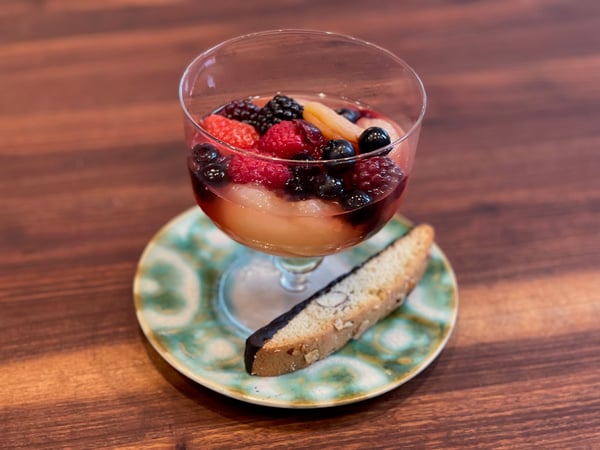 Poaching is a fundamental cooking skill and one everyone should have some mastery in. Poaching eggs and salmon have many overlapping techniques to poaching fruit, however there are some distinct differences. Fruit itself has many more varieties and each fruit holds different inherent characteristics - a pear cooks very differently than a strawberry. Poaching a really ripe pear and a rather hard and unripe pear requires different cooking times.
Poaching is a fundamental cooking skill and one everyone should have some mastery in. Poaching eggs and salmon have many overlapping techniques to poaching fruit, however there are some distinct differences. Fruit itself has many more varieties and each fruit holds different inherent characteristics - a pear cooks very differently than a strawberry. Poaching a really ripe pear and a rather hard and unripe pear requires different cooking times.
Fruit is poached in syrup, not stock or water like we would use to poaching chicken or eggs. How sweet the syrup is, effects how the fruit poaches, a heavier (sweeter) syrup assists in a very ripe fruit in not turning to mush and a light syrup (less sweet) assists a under ripe fruit in cooking more quickly. All these variables might seem daunting if you are the type of person who loves to strictly follow a recipe. Let me try and demystify some of the variables so you can conquer poaching fruit with knowledge and intuition!
Poaching as a Technique
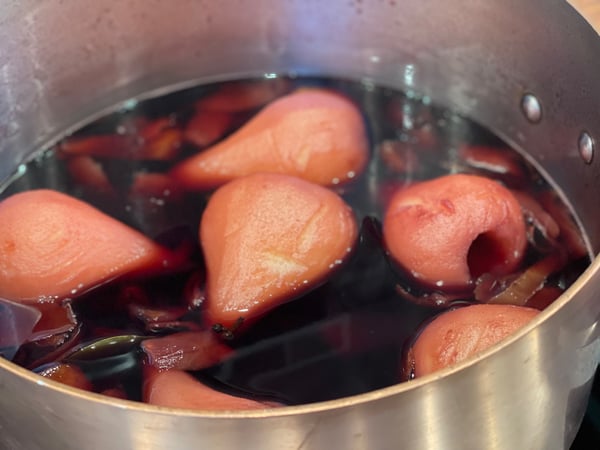 Poaching refers to cooking food, whether that be a piece of salmon, an egg or a piece of fruit, in gently simmering liquid. Poaching can be done on the stove, but it can also be done in the oven. Food is submerged in a lightly simmering liquid, uncovered. The low temperature (between 150-180 degrees) cooks the food gently and delicately, resulting in very tender and moist food. The poaching liquid is often highly seasoned, which infuses the fruit with loads of flavor.
Poaching refers to cooking food, whether that be a piece of salmon, an egg or a piece of fruit, in gently simmering liquid. Poaching can be done on the stove, but it can also be done in the oven. Food is submerged in a lightly simmering liquid, uncovered. The low temperature (between 150-180 degrees) cooks the food gently and delicately, resulting in very tender and moist food. The poaching liquid is often highly seasoned, which infuses the fruit with loads of flavor.
Temperature of Poaching Liquid
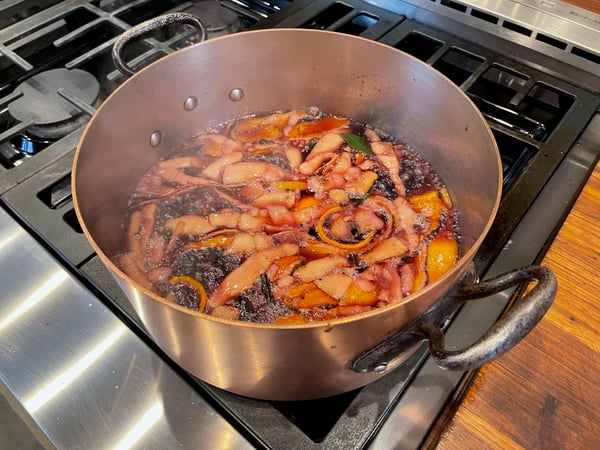 The more delicate the food, the lower the temperature the poaching liquid should be. A delicate egg cooks at approximately 158 degrees, a very low temperature. It would make sense that we do not want to have the poaching water for the egg at a temperature higher than 158 degrees. This low temperature will help to keep your poached egg from overcooking.
The more delicate the food, the lower the temperature the poaching liquid should be. A delicate egg cooks at approximately 158 degrees, a very low temperature. It would make sense that we do not want to have the poaching water for the egg at a temperature higher than 158 degrees. This low temperature will help to keep your poached egg from overcooking.
A delicate raspberry, cherry, strawberry or a very ripe peach or pear will hold their shape better with a water temperature just below a simmer. Boiling agitates the fruit and starts to break down the delicate structure. The water or liquid should have steam rising from the surface but there should be no movement or boiling of the water at all. Use your digital thermometer to take the temperature of the water. 150-180 is my preferred temperature for poaching everything, except very firm or under ripe fruit. A very under ripe apple or pear will stand up to a low simmer.
Selecting and Preparing Fruits
Stone Fruits, such as plums, peaches, apricots and cherries should be pitted. I do not peel cherries but it is optional to peel other stone fruits. The peels add color and loads of flavor so you can leave the peel on the fruit. I believe the delicate nature of poaching makes the skins of stone fruits very palatable. Of course, remove the peels if you prefer. When I peel a small amount of fruit, such as 6 to 8 pieces, I find using a sharp vegetable peeler is the quickest method.
*I like to add fruit peels to the poaching liquid as it adds a lot of flavor.
.jpg?width=450&height=600&name=apples%20(2).jpg)
Pears and apples should be peeled and cored. A sharp vegetable peeler does the trick for both peeling and coring. Keep the pears and apples submerged in cold water with a little lemon juice added to it to keep them from browning.
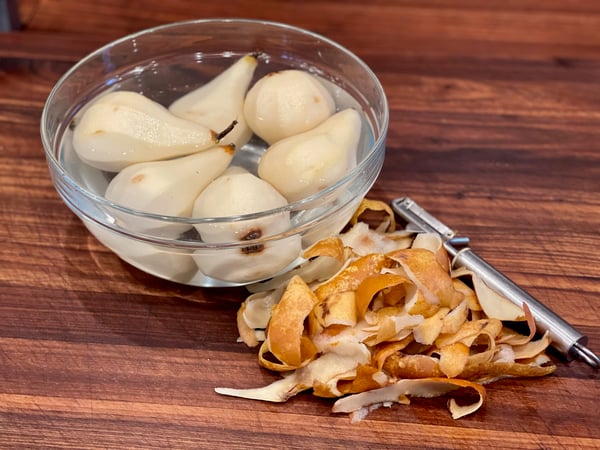 Mango, pineapple, banana and papaya should be peeled (cored or seeded) and cut into at least 1-inch pieces.
Mango, pineapple, banana and papaya should be peeled (cored or seeded) and cut into at least 1-inch pieces.
Blueberries, raspberries, strawberries, blackberries, figs, gooseberries, boysenberries, grapes and currents should be rinsed and stems removed. They can be cut in smaller pieces or left whole.
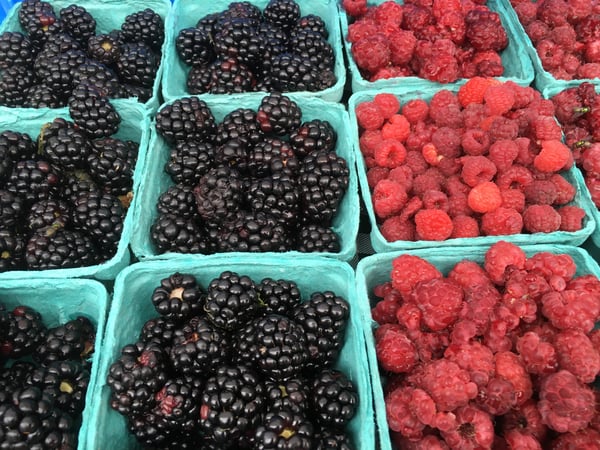
Dried fruit such as raisins, cranberries, cherries, dates, figs, apricots can be left whole or cut into smaller pieces if preferred.
Frozen fruit should be treated the same as if it were a fresh version of itself. No need to thaw the fruit, just put it directly into poaching liquid and cook it as if it were a fresh version of itself. Frozen blueberries will cook in a minute while frozen apples would take 10 to 15 minutes to cook.
Ripeness and Type of Fruit
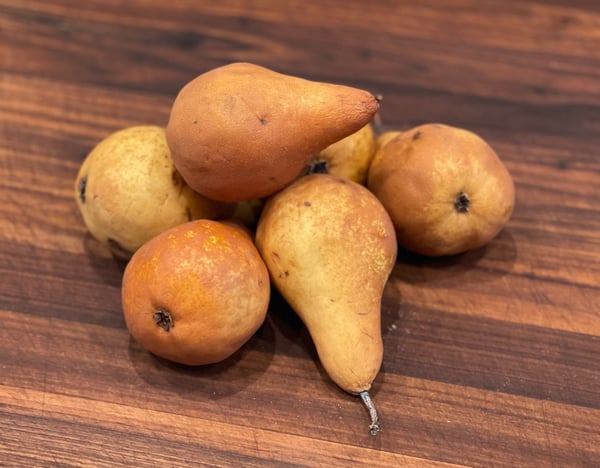 The riper the fruit, whether that be a pear or a plum, will affect how long it takes to cook the fruit. A very ripe pear or a plum will poach/cook much quicker than a very hard and unripe pear or plum.
The riper the fruit, whether that be a pear or a plum, will affect how long it takes to cook the fruit. A very ripe pear or a plum will poach/cook much quicker than a very hard and unripe pear or plum.
Fruit doesn’t have connective tissue that is affected during cooking like meat but all fruits have different moisture contents and structure. A raspberry or blackberry are so delicate and tender that they will poach in a matter of seconds. A blueberry or a strawberry will cook in just a minute or two. A cherry or a grape will cook in 3-5 minutes. A pear or an apple cook in as little as 10 minutes or as long as 25 minutes.
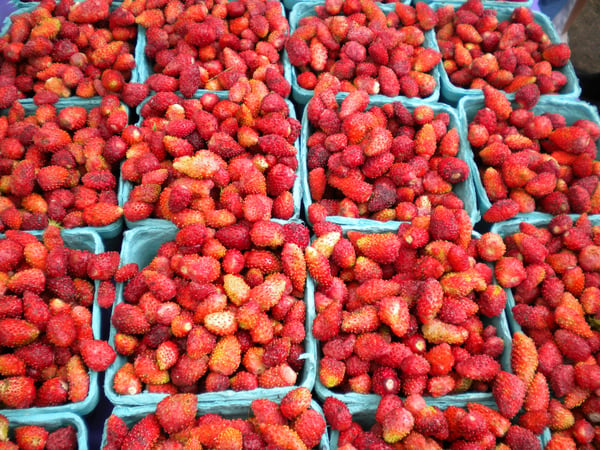 Dried fruit doesn’t need to be cooked but rather hydrated. It takes about the same amount of time to hydrate dried fruit in the poaching liquid as it does to poach a semi-ripe fresh fruit 5 to 15 minutes.
Dried fruit doesn’t need to be cooked but rather hydrated. It takes about the same amount of time to hydrate dried fruit in the poaching liquid as it does to poach a semi-ripe fresh fruit 5 to 15 minutes.
Ideally the fruit for poaching should neither be completely unripe or completely ripe. Ideally the fruit should be slightly under ripe. At the same time, one of the benefits of poaching fruit is that the cooking process can correct the under ripe texture and taste of a fruit. I don’t overly concern myself that my fruit is under ripe however I am quite leery of poaching very overripe fruit. Overripe fruit can become mushy and fall apart very easily.
Poaching Fruit Timing Guide
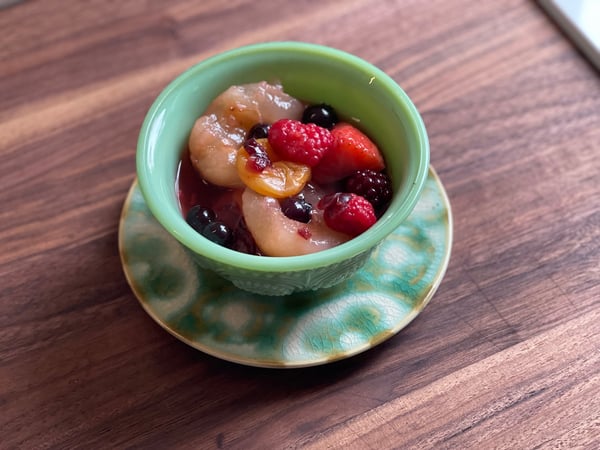 I often poach many kinds of fruits together. In fact, this is probably my favorite way of enjoying poached fruit, I love fresh and dried varieties combined. Here is the timing chart for poaching fruit.
I often poach many kinds of fruits together. In fact, this is probably my favorite way of enjoying poached fruit, I love fresh and dried varieties combined. Here is the timing chart for poaching fruit.
Pears and Apples: 10-25 minutes
Stone Fruits: Peaches, apricots, plums and cherries 5-15 minutes
Dried Fruits: Raisins, cherries, dates, figs and apricots 5-15 minutes
Blueberries, raspberries, strawberries, blackberries, boysenberries, figs, bananas, grapes and currants: 1-5 minutes
When you want to poach a combination of fruit together, you can use this information to determine at what point to add each fruit.
Sugar Syrup
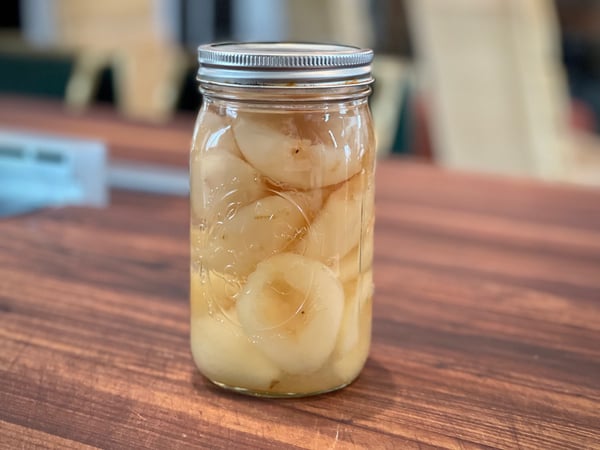 Poached fruit is cooked in a sugar syrup. The less sugar you use in the syrup the quicker the fruit will break down when it cooks. For example, when I make applesauce, I do not put the sugar in with my apples when I cook them. Apples will break down into an applesauce consistency very quickly without sugar. If you were to cook the apples with the sugar, the apples will hold their shape and not want to break down. The sugar syrup starts to “candy” the apples which has the apples hold their shape. The heavier the syrup, the more it will “candy” the fruit. When poaching fruit, we don’t want the shape of the fruit to break down, we just want the fruit to be tender. The sugar syrup is what allows this to occur by lightly candying the fruit.
Poached fruit is cooked in a sugar syrup. The less sugar you use in the syrup the quicker the fruit will break down when it cooks. For example, when I make applesauce, I do not put the sugar in with my apples when I cook them. Apples will break down into an applesauce consistency very quickly without sugar. If you were to cook the apples with the sugar, the apples will hold their shape and not want to break down. The sugar syrup starts to “candy” the apples which has the apples hold their shape. The heavier the syrup, the more it will “candy” the fruit. When poaching fruit, we don’t want the shape of the fruit to break down, we just want the fruit to be tender. The sugar syrup is what allows this to occur by lightly candying the fruit.
*Artificial sweeteners or inverted sugars cannot be substituted for sugar since these sweeteners will not candy the fruit.
When poaching fruit, cover the fruit with the poaching liquid. The tricky part is that fruit floats. In essence no matter how much poaching liquid you put in the pot, the pear will never be covered. I think of it this way, the poaching liquid should be at least the depth of the fruit. A pear at its thickest part is probably 4 inches, so you will need at least that much liquid. If you were poaching 20 pears, they would be piled on top of each other so you would need to up the quantity of poaching liquid to cover the entire pile of pears.
*If I have a very ripe pear then you need to use a medium syrup (heavier sugar) to keep the pear from falling apart.
*If I have a very under ripe pear you can use a very light syrup (light sugar) since it will cook more quickly and be less likely to breakdown.
Light Syrup Ratio
1 cup sugar
2 cups water
Medium Syrup Ratio
1 1/4 cup sugar
2 cups of water
Substitute some or all of the water for wine:
- Dry white wine such as Sauvignon Blanc or Pinot Grigio
- Dry red wine such as Cabernet Sauvignon, Merlot or Burgundy
Add 1 Tablespoon per 3 cups of syrup:
- Cognac, brandy or port
- Lemon Juice
To prepare poaching syrup, put the sugar and cold water into the pot. Turn the water on a medium heat and stir until sugar dissolves. Once sugar has dissolved, adjust the heat as needed to keep the syrup from boiling. Ideal temperature will be when steam is starting rise from the pot and the syrup is just below a simmer. At this time, the poaching syrup is ready to add the fruit.
If you want to add wine and or spices to your poaching liquid, start in the same way as you would for the plain syrup except substitute wine and or other aromatic liquids as desired. If adding spices, warm the poaching syrup with the spices and steep for at least 15 minutes so that the whole spices have time to infuse into the liquid.
*If poaching berries or small pieces of fruit, strain the poaching liquid to remove spices before adding the fruit. It can be difficult to remove the spices among the small pieces of fruit.
*If poaching a large piece of fruit like a pear, you can leave the spices in to allow more time to infuse their flavor
Flavorings
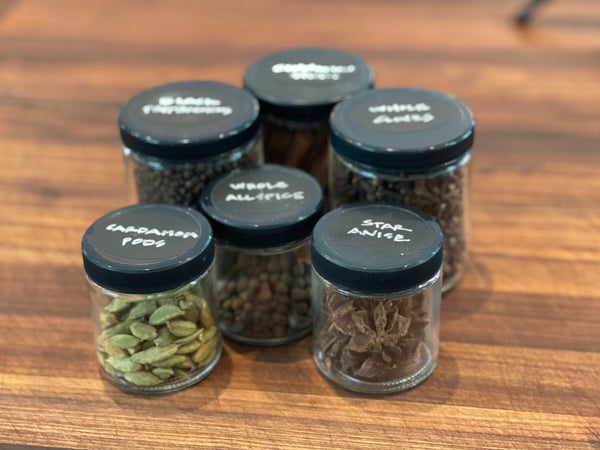 You can poach a pear in a plain simple syrup of water and sugar and it will be delicious. Perhaps you would want a simple pear like this if you were to serve it as an ingredient in a salad or on a fruit tart. There are also many ways to season poached fruit with additional flavorings. You can eliminate water all together and use all red wine or white wine for the liquid. Wine adds a ton of flavor and a subtle acidity which balances the sweetness and in the case of red wine, you gain a beautiful red color. Try using part water and part wine for less intensity. You can use water or wine with a small addition of lemon juice, cognac, brandy or port wine.
You can poach a pear in a plain simple syrup of water and sugar and it will be delicious. Perhaps you would want a simple pear like this if you were to serve it as an ingredient in a salad or on a fruit tart. There are also many ways to season poached fruit with additional flavorings. You can eliminate water all together and use all red wine or white wine for the liquid. Wine adds a ton of flavor and a subtle acidity which balances the sweetness and in the case of red wine, you gain a beautiful red color. Try using part water and part wine for less intensity. You can use water or wine with a small addition of lemon juice, cognac, brandy or port wine.
Try adding spices such as cinnamon stick, whole cardamom, whole cloves, vanilla beans, whole star anise, whole peppercorns of every color and bay leaves. Just avoid ground spices since they create a film on the fruit and muddy what should be a crystal-clear poaching liquid. Orange or lemon peel is another favorite addition.
Red Wine Poached Pear
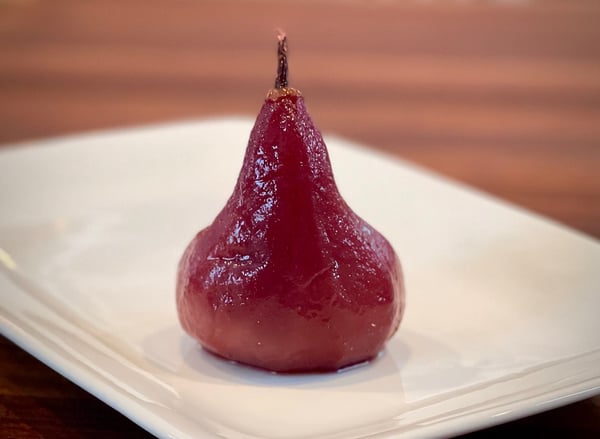 Scroll down for a printable version of this recipe
Scroll down for a printable version of this recipe
Serves: 6
Prep time: 30 minutes
Start to finish: 1 hour
3 cups of sugar
1 cinnamon stick
1 vanilla bean, split in half lengthwise
6 black peppercorns
6 whole cloves
3 pieces of orange peel
6 cups of red wine (Merlot, Cabernet Sauvignon or Burgundy)
6 semi ripe pears
1 teaspoon of lemon juice
Step 1: Prepare Poaching Liquid
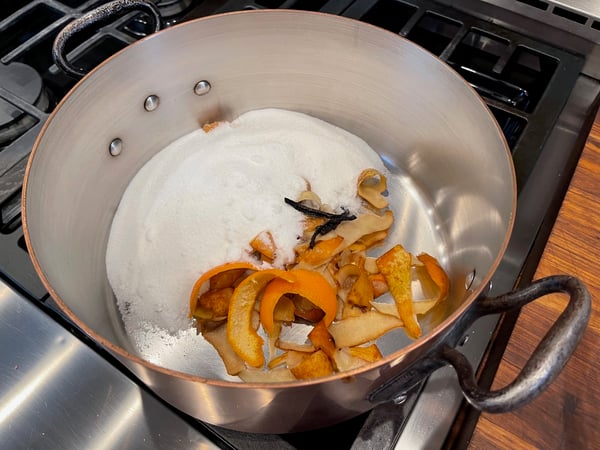
Place sugar, cinnamon stick, vanilla bean, cloves, orange peel, bay leaf and wine into a 5.5 or 8-quart stock pot. Turn the burner to a medium heat and heat just until steam rises. Hold the poaching liquid at this temperature for 15 minutes so that the flavors of the spices infuse into the liquid.
Step 2: Prepare the Fruit
Determine the ripeness of the pear. Very under ripe pears will be very hard. It is very difficult to core a completely unripe pear. If you find the pears are completely unripe when you go to core them then you will need to cook the pears whole and core them after they cook.
When slightly under ripe they will still be firm but not hard. Yellow pears are green when unripe, the green fades as the pear ripens and the pear becomes more golden yellow. A pear that is slightly under ripe will have some very faint green color and will core easily.
Next peel and core the pear but leave the stem intact. The peels adds a lovely flavor to the poaching liquid so feel free to toss them into the poaching liquid while it is steeping on the stove… compost the cores.
Cover the pears in cold water with a teaspoon of lemon juice in it to keep them from browning.
Step 3: Poach the Pears
After the poaching liquid has steeped for at least 15 minutes, add the prepared pears to the liquid. Make sure to keep the poaching syrup just below a simmer.
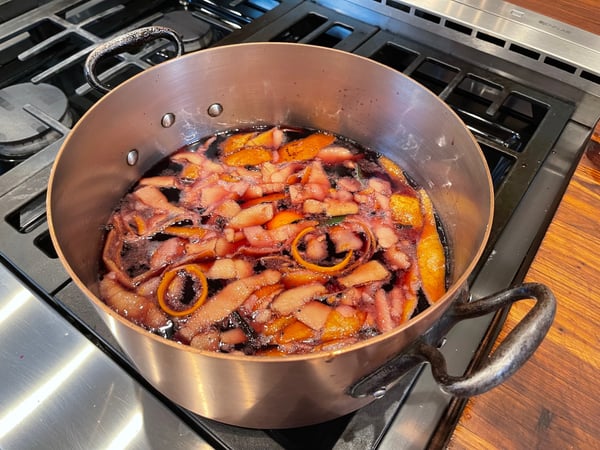 Poach the pear for approximately 5 to 8 minutes on one side and then turn the pears over and poach the second side for approximately 5 to 8 minutes.
Poach the pear for approximately 5 to 8 minutes on one side and then turn the pears over and poach the second side for approximately 5 to 8 minutes.
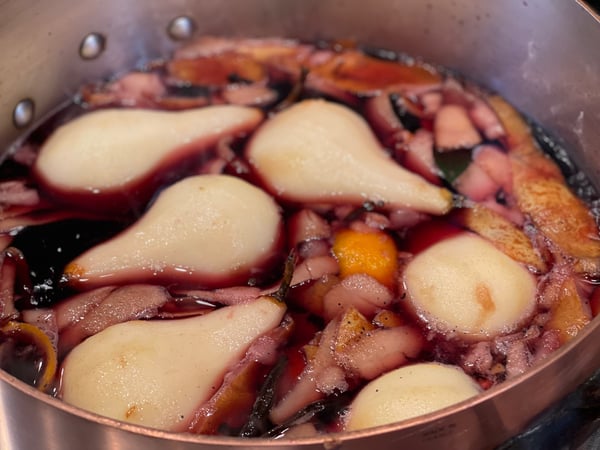 Before turning
Before turning
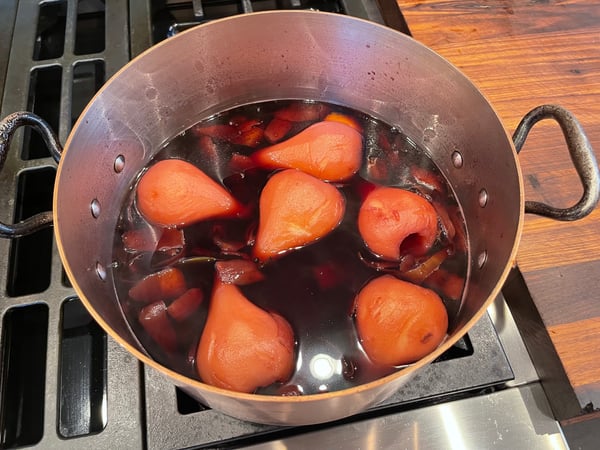
After turning
At this point, insert a knife into a pear, if it can be inserted easily the pear should be done. If the pear is still somewhat hard in the center continue to cook until a knife can be inserted easily.
After the pears are poached, they can be served immediately while they are still warm. You can also strain the poaching liquid and refrigerate the pears in the poaching liquid if you want to serve them cold. This further enhances the flavor of the pear as it sits in the poaching syrup.
*You can reduce the strained poaching liquid into a thick syrup if you desire. Simmer the liquid on the stove with pears removed until half its original volume. This syrup can be served over the pear, mixed in a cocktail or even served with French toast!
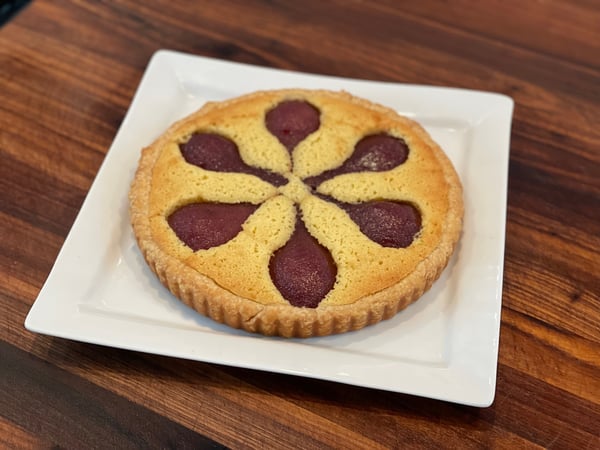 Poached pears can be served in a salad with blue cheese and walnuts, they can be used in beautiful tarts, with Crème Anglaise or on their own drizzled with the reduced poaching liquid they were cooked in. I love to serve poached fruit compote warm or cold with a nice biscotti to dip into the flavorful liquid or with a dollop of yogurt or ice cream. I hope this blog has inspired you to try this classic cooking technique.
Poached pears can be served in a salad with blue cheese and walnuts, they can be used in beautiful tarts, with Crème Anglaise or on their own drizzled with the reduced poaching liquid they were cooked in. I love to serve poached fruit compote warm or cold with a nice biscotti to dip into the flavorful liquid or with a dollop of yogurt or ice cream. I hope this blog has inspired you to try this classic cooking technique.
If you are looking for more classic techniques, consider our 5-star rated 5-day Culinary Boot Camp course where we cover poaching both eggs and fish, among many other essential cooking techniques. It's professional culinary school that is made approachable and affordable for home cooks!
Learn More about Culinary Boot Camp
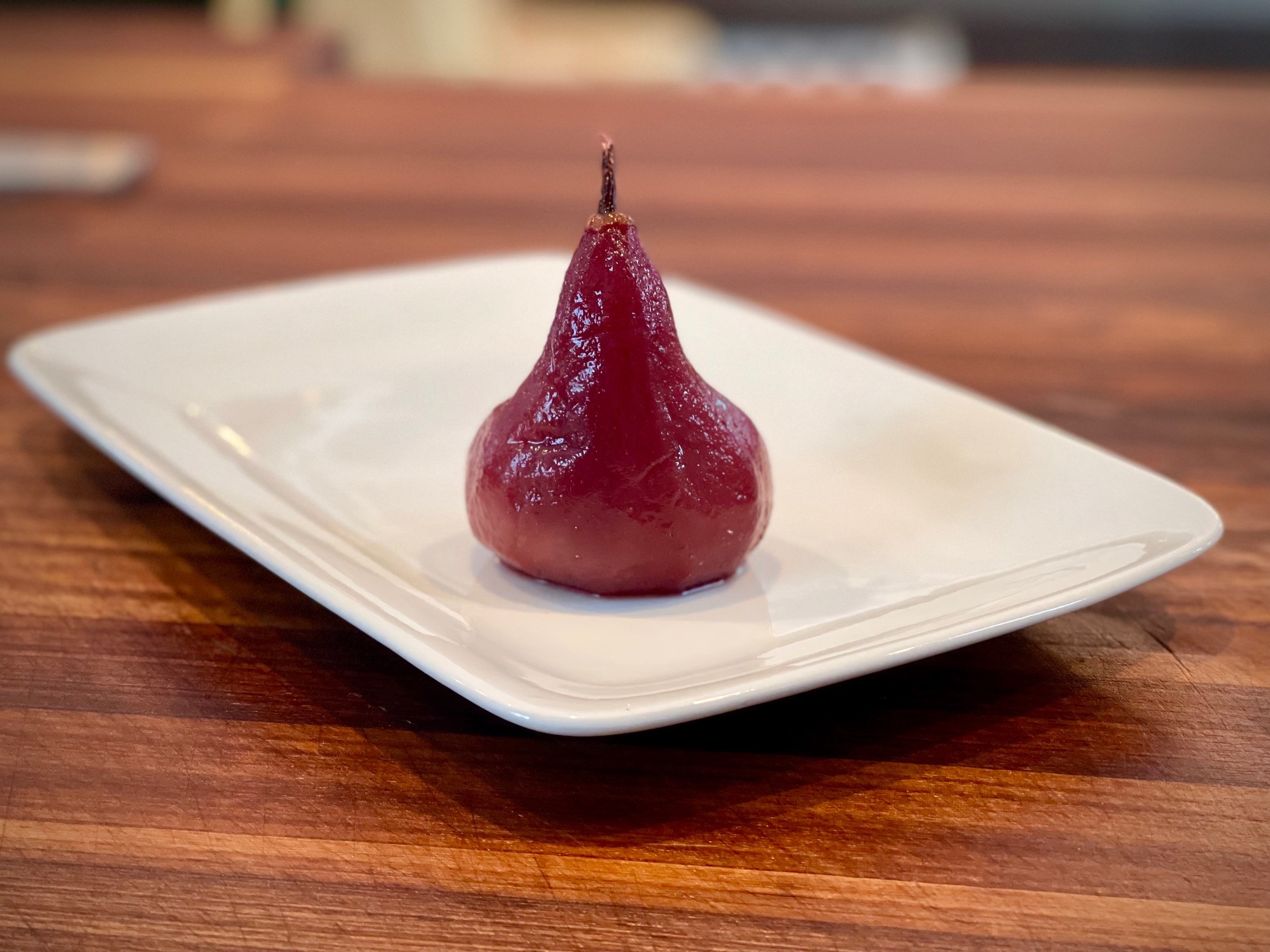
Red Wine Poached Pear
Ingredients
- 3 cups of sugar
- 1 cinnamon stick
- 1 vanilla bean, split in half lengthwise
- 6 black peppercorns
- 6 whole cloves
- 3 pieces of orange peel
- 6 cups of red wine (Merlot, Cabernet Sauvignon or Burgundy)
- 6 semi ripe pears
- 1 teaspoon of lemon juice
Instructions
- Place sugar, cinnamon stick, vanilla bean, cloves, orange peel, bay leaf and wine into a 5.5 or 8-quart stock pot. Turn the burner to a medium heat and heat just until steam rises. Hold the poaching liquid at this temperature for 15 minutes so that the flavors of the spices infuse into the liquid.
- Next peel and core the pear but leave the stem intact.
- Cover the pears in cold water with a teaspoon of lemon juice in it to keep them from browning.
- After the poaching liquid has steeped for at least 15 minutes, add the prepared pears to the liquid. Make sure to keep the poaching syrup just below a simmer.
- Poach the pear for approximately 5 to 8 minutes on one side and then turn the pears over and poach the second side for approximately 5 to 8 minutes.
- Insert a knife into a pear, if it can be inserted easily, the pear should be done. If the pear is still somewhat hard in the center, continue to cook until a knife can be inserted easily.
- After the pears are poached, they can be served immediately while they are still warm. You can also strain the poaching liquid and refrigerate the pears in the poaching liquid if you want to serve them cold.











